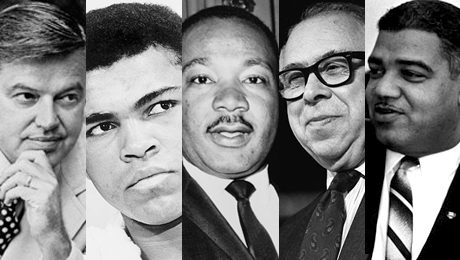By Brittney Dunkins
It’s a story ripped from a conspiracy theorist’s notebook, summoning images of men in black hats, unmarked cars, wire-tapping, documents marked “top secret” and a trail leading all the way up to the White House.
According to newly declassified documents from the National Security Agency, U.S. government agencies requested surveillance of prominent Americans during the Vietnam era through a top-secret domestic surveillance program called Project MINARET.
Targets included civil rights leader Martin Luther King Jr., heavyweight-boxing champion Muhammad Ali, Washington Post humorist Art Buchwald, Urban League President Whitney Young, New York Times D.C. Bureau Chief Tom Wicker and U.S. Senators Frank Church and Howard Baker.
Last month, the National Security Archive, a non-governmental research organization housed at the George Washington University’s Estelle and Melvin Gelman Library, released the information online. The documents are part of a four-volume redacted history of the NSA called “American Cryptology During the Cold War,” written by a former NSA historian, Thomas R. Johnson.
“I knew this was important history and worth going after,” said Archive Senior Analyst William Burr.
Dr. Burr collaborated on the project with Matthew Aid, a writer for Foreign Policy magazine and author of “The Secret Sentry,” a history of the NSA compiled from more than 25,000 pages of documents from the National Archives and Records Administration and through Freedom of Information Act (FOIA) requests.
“The National Security Archive is in the business of getting this type of information so that researchers, reporters and historians, like myself, can use it,” Mr. Aid said. “None of this would have been possible without their perseverance.”
The process of procuring the information took a total of eight years and included initial FOIA requests for redacted information in Mr. Johnson’s history and an appeals process that required the submission of a Mandatory Declassification Review Request with the Interagency Security Classification Appeal Panel.
ISCAP is composed of senior-level representatives from the Departments of State, Defense and Justice, the National Archives, the Office of the Director of National Intelligence, and the National Security Advisor. It makes declassification decisions based on a majority rule voting process.
ISCAP is the last stop for people who are not satisfied by the disclosures made by government agencies on FOIA requests, Mr. Aid said.
The response to their appeal came five years later.
“At the time that we received the first package, we had nearly 1,000 pages of the four-volume history,” Mr. Aid said. “ISCAP returned the exact same pages with the new information added, but unmarked.”
“If you can imagine, on one side of my desk was the information they’d released previously and on the other side, was the new document. I went page by page, scanning for new information and taking notes,” he said.
This “needle in a haystack” hunt required about two weeks of close review, but resulted in a number of revelations including information regarding the Cuban Missile Crisis, the raising of the Berlin Wall, the Pentagon Papers and the 1977 Panama Canal Treaty.
Documents revealing the targets of Project MINARET’s “disreputable if not downright illegal” activities, which operated from 1961 to 1973, were the most high profile, given the personalities involved.
It is well known that Dr. King was under surveillance, due to his outspoken stance against the Vietnam War, his association with former Communist Party Member Stanley Levison, who served as one of his chief advisers, and his influential status.
“Any man who can get a million people to march on Washington constituted, in J. Edgar Hoover’s mind, a threat to national security,” Mr. Aid said.
It is assumed that Mr. Young was added to the list when he publicly voiced his opposition to the war in 1969. This is also the logic behind the surveillance of Mr. Wicker and Mr. Buchwald who used their status in the newspaper industry to voice criticism of the war.
Anti-war sentiments are likely also at the root of surveillance of Mr. Ali, who famously attempted to avoid the draft and served five years in prison before the Supreme Court eventually declared his right to conscientious objector status.
Sen. Church’s nomination to the list is most likely tied to his 1965 declaration that the U.S. government was doing “too much” in response to President Lyndon B. Johnson’s decision to escalate the war.
Perhaps the most surprising name on the list is Sen. Baker, an ardent supporter of the war.
The documents do not reveal why or how the targets were chosen.
“The NSA doesn’t choose who to put under surveillance,” Dr. Burr said. “Agencies have to forward a requirement to have people added.”
“It is worrying to think that the NSA has only rejected four recommendations for surveillance since its inception,” Dr. Burr added.
The requirements for surveillance have yet to be declassified, which raises issues about control and oversight of these programs, Mr. Aid said.
“The overarching issue surrounding the power of organizations like NSA that operate in secret is that there is no transparency,” Mr. Aid said. “There is no advocate.”
This makes the role of organizations like the National Security Archive even more important, he said.
“With projects such as this, the archive is trying to find out the extent to which these organizations operate,” he said. “The next step is to go back to NSA and ask for more information.”


